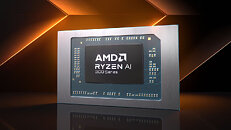AMD Ryzen AI 5 330 “Krackan Point 2” Silicon Has 1P+3C Cores

A successor to “Phoenix 2,” Krackan Point 2, as configured on the Ryzen AI 5 330, comes with a single heterogenous CCX that has four cores, one of these is a regular “Zen 5,” and the other three “Zen 5c” cores. The four cores each have 1 MB of L2 cache, and share 8 MB of L3 cache. All four cores come with a base frequency of 2.00 GHz, but while the lone “Zen 5” core boosts up to 4.50 GHz, the three “Zen 5c” cores only boost up to 3.40 GHz. All four cores come with SMT, and share a common ISA, so threads can migrate among them seamlessly without encountering runtime errors. A software-based power management solution uses UEFI CPPC2-based “preferred core” flagging to ensure priority to the “Zen 5” core. The chip comes with a default TDP of 28 W, although OEMs can configure this between 15 W and 28 W.

Elsewhere in the chip is a tiny iGPU based on the RDNA 3.5 graphics architecture, which only has one WGP (workgroup processor), or 2 compute units (128 stream processors). On the Ryzen AI 5 330, this comes with an engine clock boost of 2.80 GHz. The display- and media acceleration engines are carried over from “Strix Point.”
The star attraction with this chip is the NPU, and AMD has given this chip a full-sized Ryzen AI XDNA 2 NPU carried over from “Strix Point,” with a throughput of 50 TOPS, making this processor eligible for Microsoft Copilot+ local acceleration logo. This is what makes things exciting for OEMs, as they can now bring Copilot+ to mainstream notebooks priced well below the $500-mark, perhaps even below $400.












